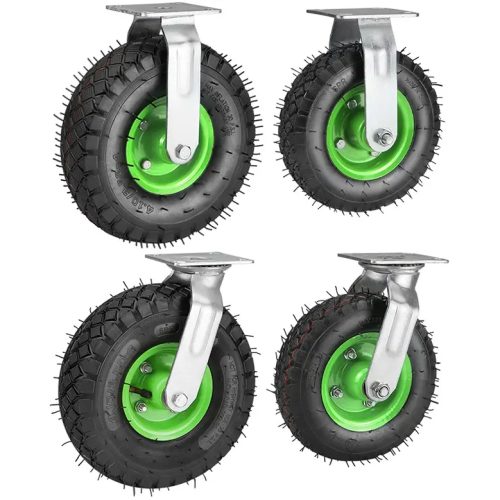Selecting the right pneumatic caster for your specific application is a crucial decision that can significantly impact the efficiency and safety of your material handling tasks. With a wide range of options available in the market, it’s essential to understand the key factors that influence your choice. In this comprehensive guide, we’ll explore the considerations and steps to help you make an informed decision.
1. Load Capacity
The first step in choosing the right pneumatic caster is to determine the load capacity you require. Consider the maximum weight your equipment or cart will carry. Ensure that the caster’s load capacity exceeds this weight to provide a safety margin. Pneumatic casters come in various load capacity ratings, so be sure to match your needs accordingly.
2. Wheel Diameter
The wheel diameter plays a crucial role in the caster’s performance. Larger wheels generally provide better stability and smoother movement, making them suitable for rough terrains or uneven surfaces. Smaller wheels are more maneuverable and work well in confined spaces. Choose the wheel diameter that suits your application’s specific demands.
3. Tread Material
Pneumatic casters feature different tread materials, including rubber, polyurethane, and other specialty compounds. The choice of tread material depends on the type of surface the caster will be used on. Rubber treads offer good shock absorption, while polyurethane treads are durable and resistant to chemicals and abrasion. Consider your workplace conditions when selecting the appropriate tread material.
4. Bearing Type
Caster bearings significantly impact the ease of rolling and maneuverability. There are generally two types of bearings used in pneumatic casters: ball bearings and roller bearings. Ball bearings offer smoother rolling, while roller bearings can handle heavier loads. Choose the bearing type that aligns with your application’s demands.
5. Brake Options
For enhanced control and safety, consider whether your application requires casters with brakes. Brakes can be swivel locks, wheel brakes, or total locks, each serving a specific purpose. Swivel locks allow you to fix the direction of the caster, wheel brakes stop the wheel’s rotation, and total locks provide both swivel and wheel locking. Evaluate your needs and select the appropriate brake mechanism.
6. Environment and Temperature
Consider the environment in which the pneumatic casters will operate. If your application is in a wet or corrosive environment, stainless steel or corrosion-resistant casters may be necessary. Furthermore, think about temperature extremes. Some casters are designed to perform well in both hot and cold conditions, while others may become less effective in extreme temperatures.
7. Swivel vs. Rigid Casters
Determine whether you need swivel casters, rigid casters, or a combination of both. Swivel casters offer increased maneuverability, while rigid casters provide stability. A combination of both types can be suitable for applications that require both ease of movement and controlled direction.
In conclusion, choosing the right pneumatic caster involves careful consideration of load capacity, wheel diameter, tread material, bearing type, brake options, environmental conditions, and the need for swivel or rigid casters. By taking these factors into account, you can select the pneumatic casters that will optimize your material handling operations and contribute to workplace safety and efficiency.


